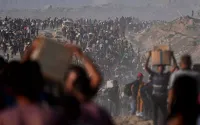Edmund L. Andrews27 Februaray 2008
Having already slashed short-term interest rates by almost half since August, the chairman of the Federal Reserve, Ben S. Bernanke, signaled on Wednesday that more rate cuts — which is to say more cheap money — may lie ahead.Mr. Bernanke’s assumption is that slowing economic growth will reduce inflationary pressures in the months ahead, because debt-laden consumers will be far more wary of spending money and businesses will be more cautious about investing in more plant and equipment.
But the success or failure of the Fed’s strategy could depend on something outside Mr. Bernanke’s immediate control: foreign confidence in the American dollar and foreign willingness to keep financing the United States’ huge external debt.
The dollar has plunged against most major currencies since the Federal Reserve first began cutting interest rates in September, and slipped to another all-time low against the euro after Mr. Bernanke’s testimony on Wednesday to the House Financial Services Committee.
A weak dollar tends to boost American exports by making them cheaper in foreign markets, but it also pushes up inflation by raising the cost of foreign imports. And while the United States buys oil in dollars, many analysts contend that part of the recent run-up in oil prices is tied to the steadily declining value of the dollar.
Over the long haul, the bigger worry for Mr. Bernanke may not be import prices as much as interest rates and the dollar’s value. While the Fed has direct control over overnight interest rates, long-term interest rates for mortgages and business purposes are affected in large measure by the flow of trillions of dollars in cheap foreign money.
Foreign capital inflows were a crucial contributor to the boom in housing prices and the persistence of low mortgage rates even after the Fed raised rates in 2004. If capital flows are now slower, or come with higher demands, mortgage rates are likely to stay high even if the Fed cuts its benchmark rate.
Even as Mr. Bernanke repeated the Fed’s mantra about closely monitoring inflation trends, investors on Wall Street immediately recognized that the Fed chairman was leaving the door open to lower interest rates when he promised to provide “insurance” against a possible downturn.
An old rule of thumb in monetary policy, seared into the memory of policy makers in the late 1970s, is that it is much easier to fix a mistake about economic growth than it is to fix one about inflation.
But as the Fed grapples with both the clear danger of a recession and rising consumer prices, policy makers are now putting far more emphasis on fighting a slowdown than on fighting inflation.
In his testimony Wednesday, Mr. Bernanke acknowledged that the central bank faces increasingly contradictory pressures of slowing growth and rising consumer prices.
The “economic situation has become distinctly less favorable” since last summer and “the risks to this outlook remain on the downside,” he told the House panel, whose leaders focused on the deep slump in the housing industry.
Mr. Bernanke signaled that at least for now, policy makers are more worried about averting or at least softening a possible recession.
Though the Fed is still predicting that the economy will narrowly escape a recession, policy makers have slashed their forecasts for growth in 2008 to less than 2 percent and expect almost no expansion during the first six months of this year.
But Mr. Bernanke warned that even that forecast may prove optimistic. He predicted that the housing downturn will continue to slow the economy “in the coming quarters,” noting that financial markets are still in turmoil and that it has become more difficult to obtain credit. Consumer spending has “slowed significantly,” he said, partly because of rising gasoline prices, slowing job growth and the decline in household wealth as a result of falling home prices.
In exchanges with the lawmakers, Mr. Bernanke agreed that regulation needed to be tighter, or at least more efficient, to avoid another epidemic of mortgage defaults, and for that matter to deter abuses in the credit-card industry.“We don’t want to create a chilling effect,” Mr. Bernanke said. “We don’t want to shut down these markets. We just want them to work better and, in particular, we think it’s important for consumers to have a better understanding of what it is that they’re buying when they purchase products in these markets.”The Federal Reserve has proposed rules intended to curb shady lending practices and impose more clarity on lending terms.
The committee chairman, Representative Barney Frank, Democrat of Massachusetts, said it was clear that the housing collapse was due in large measure to “the ideology of deregulation.”
“We are in the most significant economic troubles since at least 1998,” Mr. Frank said. “And the single biggest cause was a failure for regulation to keep up with innovation. And it’s, of course, had international consequences as well.”
Mr. Frank said he had often agreed with Mr. Bernanke’s predecessor, Alan Greenspan, whom he credited with patient and prudent leadership on monetary policy. “But in another area I think he erred,” Mr. Frank said. “His view that regulation was almost never required.”
The committee’s ranking Republican, Representative Spencer Bachus of Alabama, was less pessimistic than Mr. Frank. He said he was confident that the Fed’s careful monitoring “combined with responses from the private sector and the natural operation of the business cycle” would steady the economy sooner rather than later.
But he went on, “One lesson we’ve learned from the subprime contagion is just how highly interconnected our financial markets are.” Mr. Bachus cautioned against “overregulation” caused by different agencies monitoring different sectors of the economy.
“But there may be gaps in the regulation, and I wonder if that is in fact the case,” he said. “There may be areas where the regulation needs to be strengthened or regulation needs to be coordinated better between different regulators, both state and federal.”
Mr. Bernanke tried to make it clear that the Fed is watching inflation closely. He acknowledged that inflation may climb slightly more rapidly than the policy makers projected in January. Fed officials then estimated that consumer prices would climb to a range of 2.1 percent to 2.4 percent in 2008.
“Any tendency of inflation expectations to become unmoored or for the Federal Reserve’s inflation-fighting credibility to be eroded would greatly complicate the task of sustaining price stability and could reduce the flexibility of the F.O.M.C.,” Mr. Bernanke warned Wednesday, referring to the Federal Open Markets Committee, which sets interest rates.
“Accordingly, in the months ahead, the Federal Reserve will continue to closely monitor inflation and inflation expectations.”
But even as he acknowledged the growing dilemma between fighting the downturn and fighting inflation, Mr. Bernanke appeared to put more weight on promoting growth and made it clear he has not shut the door on more reductions in interest rates.
Noting that monetary policy “works with a lag,” the Fed chairman said, “it is important to recognize that downside risks to growth remain.”
More important, he repeated the Fed’s recent promises to “act in a timely manner as needed to support growth and provide adequate insurance to downside risks.”






